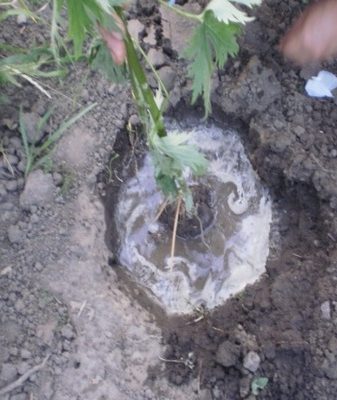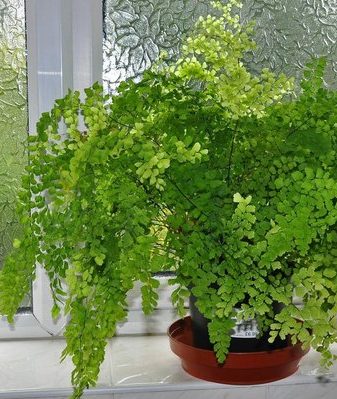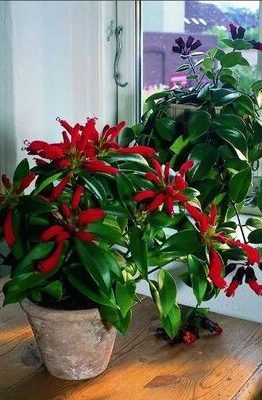Garden rhododendron
Content:
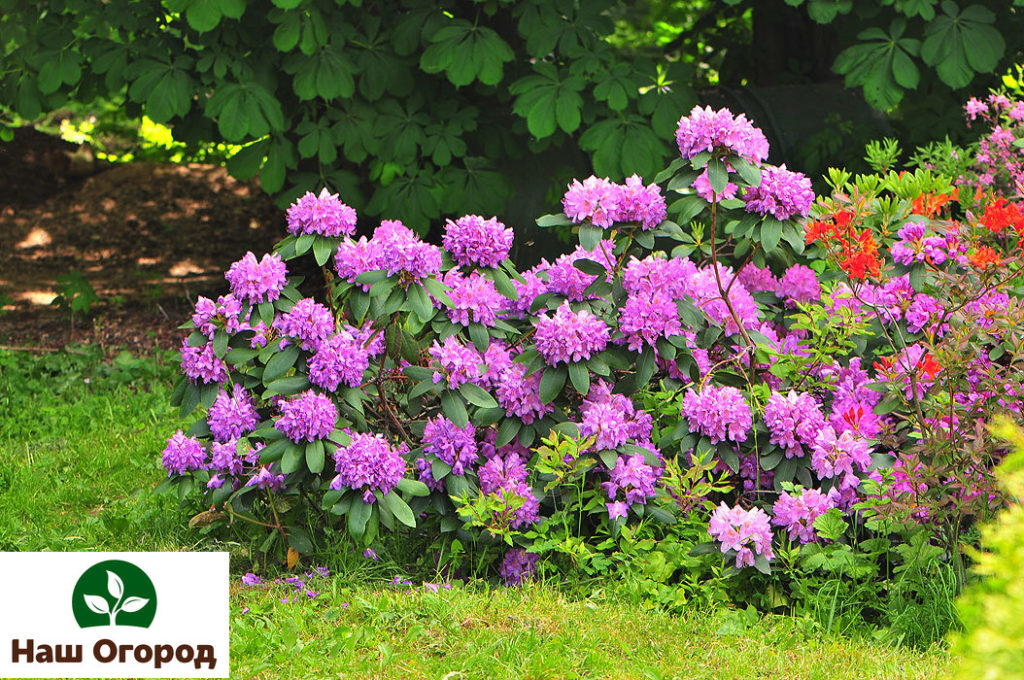
Rhododendron is a plant not only with a complex name, but also difficult to care for. Not every summer resident can cope with it on a garden plot, but if you work hard and approach the growing process with all responsibility, you will understand that these beautiful plants were worth all the effort.
Subject to competent agricultural technology, rhododendrons will bloom throughout the season, pleasing your eye with their beauty. Let's take a closer look at these bizarre plants, maybe you will decide on this interesting experiment?
Garden rhododendron: planting a flower in the open field
When choosing a site for planting Rhododendrons, do not forget that they have high requirements for natural, uniform lighting throughout the day. However, some species can grow in partial shade, but it is best to ask this in advance.
Rhododendron bushes are recommended to be planted in the early spring period or from August to early September. The hole should be dug in accordance with the dimensions of 50 by 50 and 50 centimeters.
At the bottom of each pit, drainage is laid in an even layer no thicker than 20 centimeters, which may consist of crushed bricks, gravel or other materials.
So you can always buy a ready-made drainage in a specialized store if you want to make your work easier or do not have enough materials.
Subsequently, the pit should be filled with a pre-prepared mixture - peat is used for its preparation, earth with the addition of coniferous litter or sawdust as an alternative.
As for fertilizers of a mineral nature, it is necessary to apply about 100 grams of granulated agriculture for flowering plants. All components should be thoroughly mixed together, then fill the planting hole and leave alone for an interval of 10 to 12 days before the planting process.
It is recommended to use soil containers for planting the rhododendrons in which they were grown for this - this way the plants will be less stressed from transplanting and better adapt to new conditions. The likelihood of overexposure is also excluded.
In the process of planting a rhododendron, you should not deepen the root collar - remember this. After the planting has already been made, it is necessary to water the place abundantly, first with water, and then with a growth stimulant.
At the end of the whole event, the bushes must be mulched with peat, the layer of which should not be thinner than 10 centimeters.
The mulching process is mandatory due to the fact that the root system of rhododendron lies, as a rule, in the upper layers of the soil and is more vulnerable to external factors.
The acidity level of the soil supposed for planting must be determined in advance - slightly acidic or neutral areas, properly moistened, are allowed. Subject to competent agricultural technology, plants can remain and function in one place for 15 to 20 years.
Feeding and caring for Rhododendrons
Already a year after the garden Rhododendron flower was planted in the ground, it is necessary to fertilize with acidic fertilizers in two steps.
In the early spring period around April and after the end of flowering, dry dressing is applied - a mixture of ammonium sulfate or potassium sulfate is prepared, you can also use superphosphate.
Spreading fertilizers follows from the norm of the amount of 2 tablespoons per 1 square meter. For the third year, you should plan 3 dressings at once for the entire summer period.
The first time this happens in the spring season, you just need to scatter about 2 tablespoons of nitrophoska around the perimeter of the plant.
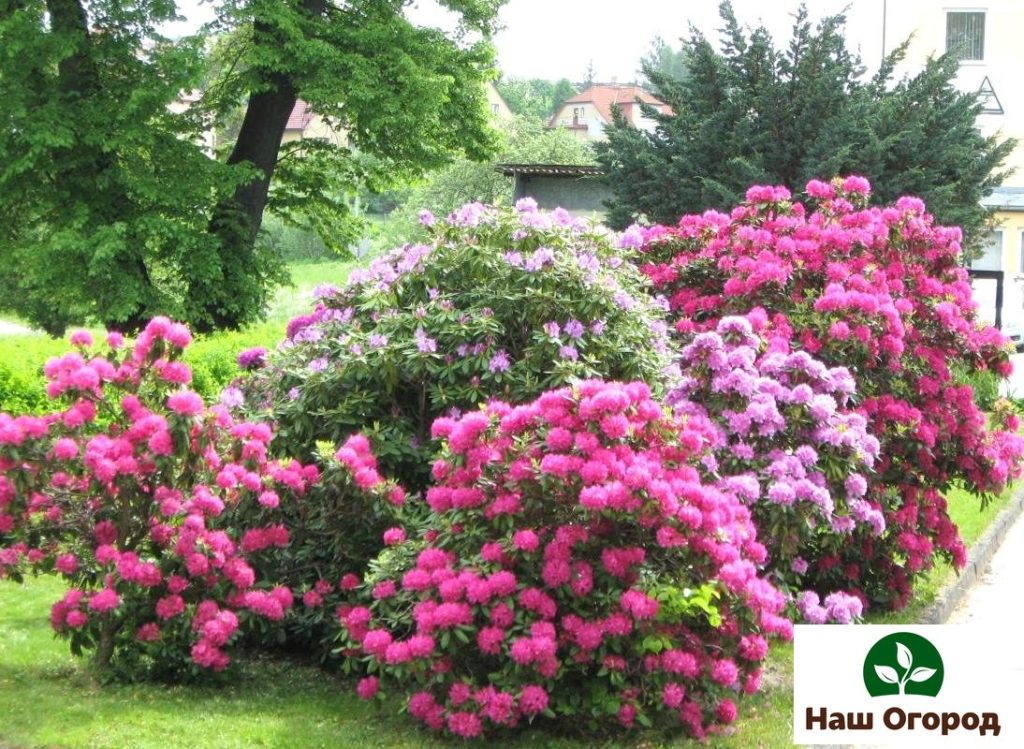
The second feeding is done at the very beginning of flowering - a solution is prepared by diluting 2 tablespoons of agriculture for flowering plants in 10 liters of water.
As for the third, final top dressing, it should be done after the flowering is completed - for 10 liters of water there are 1 tablespoon of potassium sulfate and superphosphate. The approximate consumption is determined by the amount of 3 liters for each individual bush.
Lime and wood ash should not be used in this case, as they can neutralize the effect of acidic fertilizers.
Caring for rhododendron involves, first of all, regular and abundant watering in a verified mode, which is especially important for dry, hot weather.
Watering rates are determined by values from 12 to 15 liters for each bush with a frequency of 2 times a week. It is not necessary to loosen the soil after each watering too deeply, as otherwise there is a risk of mechanical damage to the root system.
In order for the soil not to dry out and retain a sufficient amount of moisture in it, it should be subjected to timely mulching.
Rhododendron: species
Let's highlight several types of rhododendrons.
The strongest of them in terms of growth is Rhododendron Grindiflorum... This species is characterized by reaching a height of 3 meters and a width of 5 meters upon reaching the age of 60.
The flowers are large enough, presentable in appearance, delicate color, which can combine several shades at once.
Flowering time is from May to June. Resistance to low temperatures down to -28 degrees in winter is noted.
Another advantageous feature is the good tolerance of polluted air. Grindiflorum grows only in shaded areas, being under direct sun is highly discouraged.
Rhododendron Caucasian - a species that is a shrub reaching a maximum height of 1 meter. The leaves have a leathery texture, a dark green color, and a characteristic curled edge. The length of the leaves ranges from 10 to 12 centimeters.
The flowers are quite large in size, white or creamy in color. Diameter - about 3-4 centimeters, localized on average 7 or 9 pieces.
Flowering begins in June and ends in August. Advantages include tolerance to the lime content of the soil.
This species can successfully hibernate under the snow without the risk of rotting away; it also adapts well in shaded areas. The plant is used for both single and group plantings.
Rhododendron canadian is a deciduous shrub of low growth, rarely reaching a height of more than 1 meter throughout the entire life cycle.
Differs in the presence of smooth branches, oblong leaves from 2 to 4.5 centimeters long, cast in green or bluish tones.
Large-sized flowers, most often pink or purple, are located from 3 to 7 pieces on shortened branches. Blooming time is in May, even before the leaves appear.
The flowering period of this Rhododendron is characterized as long and plentiful, up to a month. Features of rhododendron
Canadian is photophilous and resistant to low temperatures, however, plantings of young ages still need timely shelter for the winter.
The lifespan of this species of Rhododendron is determined by a value of 20 years or even more. The best conditions for a plant are growing on moist soils with a low level of acidity. Looks more harmonious as part of groups than in the form of single landings.


